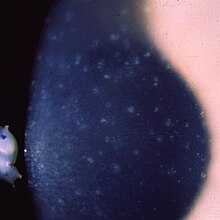| Meesmann Corneal Dystrophy | |
|---|---|
| Other names | Meesmann Epithelial Corneal Dystrophy Meesmann-Wilke Syndrome |
 | |
| Multiple opaque spots in the corneal epithelium | |
| Specialty | Ophthalmology |
| Symptoms | Anterior corneal intraepithelial microcysts, Corneal erosions, Photophobia, Lacrimation, Intermittent visual, acuity loss (rarely seriously impaired), Nonprogressive corneal dystrophy, Fine punctate corneal opacities, Episodic foreign body sensation, Increased tear production, eye stinging, Blepharospasm |
| Usual onset | Infancy or Young Childhood |
| Duration | Lifelong |
| Types | Meesmann corneal dystrophy 1, Meesmann corneal dystrophy 2 |
| Diagnostic method | Slit Lamp Biomicroscopy |
| Treatment | Eye drops, Corneal Surgery |
Meesmann corneal dystrophy (MECD) is a rare hereditary autosomal dominant disease that is characterized as a type of corneal dystrophy and a keratin disease. MECD is characterized by the formation of microcysts in the outermost layer of the cornea, known as the anterior corneal epithelium. The anterior corneal epithelium also becomes fragile. This usually affects both eyes rather than a single eye and worsens over time. There are two phenotypes, Meesmann corneal dystrophy 1 (MECD1) and Meesmann corneal dystrophy 2 (MECD2), which affect the genes KRT3 and KRT12, respectively. A heterozygous mutation in either of these genes will lead to a single phenotype.[1][2] Many with Meesmann corneal dystrophy are asymptomatic or experience mild symptoms.[3]

It is named after the German ophthalmologist Alois Meesmann (1888–1969).[4][5] It is often considered as the "Meesmann-Wilke syndrome", after the joint contribution of Meesmann and Wilke in 1939.[4][6] Research was later contributed by Stocker and Holt in 1954 through 1955 who found a variant of Meesmann corneal dystrophy called "Stocker-Holt Dystrophy".[3]
- ^ Greiner, Jack V.; Lindsay, Michael E.; Kenyon, Kenneth R.; Herman, John P.; Reddy, Chaitanya V. (December 2017). "Meesmann epithelial corneal dystrophy: recurrence following photorefractive keratectomy". Canadian Journal of Ophthalmology. 52 (6): e211–e213. doi:10.1016/j.jcjo.2017.05.009. ISSN 0008-4182. PMID 29217044.
- ^ Allen, Edwin H.A.; Courtney, David G.; Atkinson, Sarah D.; Moore, Johnny E.; Mairs, Laura; Poulsen, Ebbe Toftgaard; Schiroli, Davide; Maurizi, Eleonora; Cole, Christian; Hickerson, Robyn P.; James, John (2016-01-11). "Keratin 12 missense mutation induces the unfolded protein response and apoptosis in Meesmann epithelial corneal dystrophy". Human Molecular Genetics. 25 (6): 1176–1191. doi:10.1093/hmg/ddw001. ISSN 0964-6906. PMC 4764196. PMID 26758872.
- ^ a b Cite error: The named reference
:0was invoked but never defined (see the help page). - ^ a b synd/3139 at Who Named It?
- ^ A. Meesmann. Klinische und anatomische Untersuchungen über eine bisher unbekannte, dominant vererbte Dystrophia epithelialis corneae. Bericht der Deutschen ophthalmologischen Gesellschaft, Heidelberg, 1938, 52: 154-158.
- ^ A. Meesmann, F. Wilke. Klinische und anatomische Untersuchungen über eine bisher unbekannte, dominant vererbte Epithel Dystrophie der Horn haut. Klinische Monatsblätter für Augenheilkunde, Stuttgart, 1939, 103: 361-391.